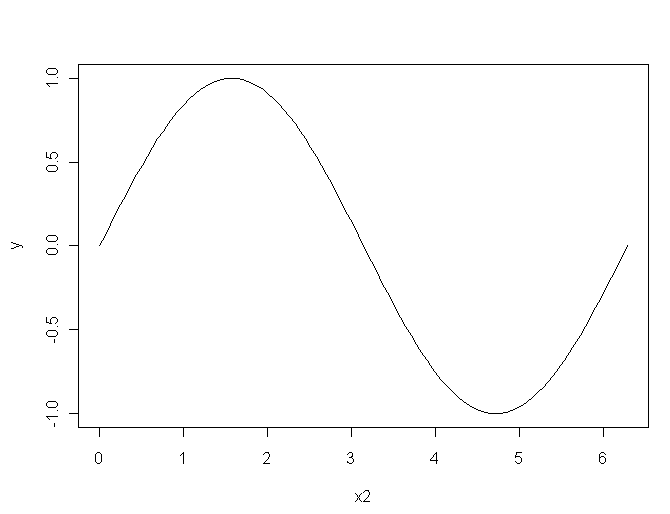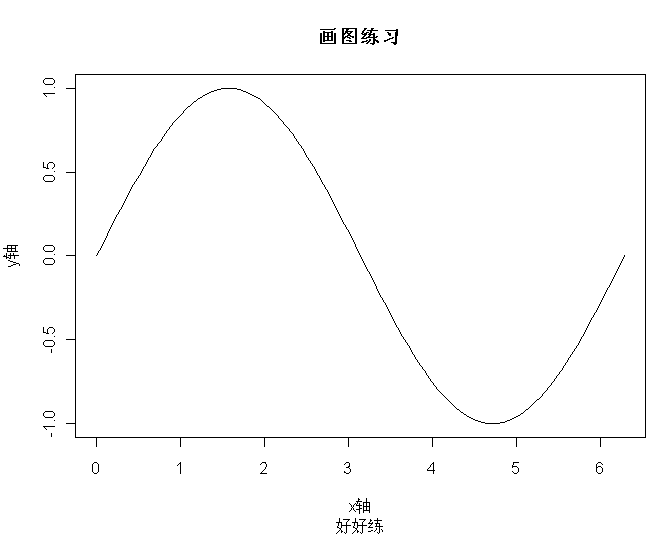第一讲
应用实例
我们用一些例子来看R软件的特点。假设我们已经进入了R的交互式窗口。如果没有打开的图形窗口,在R中,用:> x11() 可以打开一个作图窗口。然后,输入以下语句:
x1 = 0:100
x2 = x1*2*pi/100
y = sin(x2)
plot(x2,y,type="l")
这些语句可以绘制正弦曲线图。其中,“=”是赋值运算符。0:100表示一个从0到100 的等差数列向量。第二个语句可以看出,我们可以对向量直接进行四则运算,计算得到的x2 是向量x1的所有元素乘以常数2*pi/100的结果。从第三个语句可看到函数可以以向量为输入,并可以输出一个向量,结果向量y的每一个分量是自变量x2的每一个分量的正弦函数值。

plot(x2,y, type="l",main="画图练习",sub="好好练", xlab="x轴",ylab='y轴')

有关作图命令plot的详细介绍可以在R中输入help(plot)
数学函数
abs,sqrt:绝对值,平方根 log, log10, log2 , exp:对数与指数函数 sin,cos,tan,asin,acos,atan,atan2:三角函数 sinh,cosh,tanh,asinh,acosh,atanh:双曲函数
简单统计量
sum, mean, var, sd, min, max, range, median, IQR(四分位间距)等为统计量,sort,order,rank与排序有关,其它还有ave,fivenum,mad,quantile,stem等。
下面我们看一看S的统计功能:
> marks <- c(10, 6, 4, 7, 8)
> mean(marks)
> sd(marks)
> min(marks)
> max(marks)
第一个语句输入若干数据到一个向量,函c()用来把数据组合为一个向量。后面用了几个函数来计算数据的均值、标准差、最小值、最大值。
可以把若干行命令保存在一个文本文件中,然后用source函数来运行整个文件:
> source("C:/l.R")
注意字符串中的反斜杠。
例:计算6, 4, 7, 8,10的均值和标准差,把若干行命令保存在一个文本文件(比如C:\1.R)中,然后用source函数来运行整个文件。
a<- c(10, 6, 4, 7, 8)
b<-mean(a)
c<-sd(a)
source("C:/1.R")
时间序列数据的输入
使用函数ts
ts(1:10, frequency = 4, start = c(1959, 2))
print( ts(1:10, frequency = 7, start = c(12, 2)), calendar = TRUE)
a<-ts(1:10, frequency = 4, start = c(1959, 2))
plot(a)
将外部数据读入R
read.csv
默认header = TRUE,也就是第一行是标签,不是数据。
read.table
默认header = FALSE
将R中的数据输出
write
write.table
write.csv
第二讲
1. 绘制时序图、自相关图
例题2.1
d=scan("sha.csv")
sha=ts(d,start=1964,freq=1)
plot.ts(sha) #绘制时序图
acf(sha,22) #绘制自相关图,滞后期数22
pacf(sha,22) #绘制偏自相关图,滞后期数22
corr=acf(sha,22) #保存相关系数
cov=acf(sha,22,type = "covariance") #保存协方差
图的保存,单击选中图,在菜单栏选中“文件”,再选“另存为”。
同时显示多个图:用x11()命令生成一个空白图,再输入作图命令。
2. 同时绘制两组数据的时序图
d=read.csv("double.csv",header=F)
double=ts(d,start=1964,freq=1)
plot(double, plot.type = "multiple") #两组数据两个图
plot(double, plot.type = "single") #两组数据一个图
plot(double, plot.type = "single",col=c("red","green"),lty=c(1,2)) #设置每组数据图的颜色、曲线类型)
3.产生服从正态分布的随机观察值
例题2.4 随机产生1000白噪声序列观察值
d=rnorm(1000,0,1) #个数1000 均值0 方差1
plot.ts(d)
4.纯随机性检验
例题2.3续
d=scan("temp.csv")
temp=ts(d,freq=1,start=c(1949))
Box.test(temp, type="Ljung-Box",lag=6)
5.差分计算
x=1:10
y=diff(x)
k步差分 加入参数 lag=k
加入参数 lag=k
如计算x的3步差分为
y=diff(x, lag = 3)
p阶差分  加入参数differences = p
加入参数differences = p
如2阶差分
y=diff(x,differences = 2)
第三讲
例题3.1
plot.ts(arima.sim(n = 100, list(ar = 0.8)))
#模拟AR(1)模型,并作时序图。
plot.ts(arima.sim(n = 100, list(ar = -1.1)))
#非平稳,无法得到时序图。
plot.ts(arima.sim(n = 100, list(ar = c(1,-0.5))))
plot.ts(arima.sim(n = 100, list(ar = c(1,0.5))))
例题3.5
acf(arima.sim(n = 100, list(ar = 0.8)))
acf (arima.sim(n = 100, list(ar = -1.1)))
acf (arima.sim(n = 100, list(ar = c(1,-0.5))))
acf (arima.sim(n = 100, list(ar = c(1,0.5))))
例题3.7
arima.sim(n = 1000, list(ar = 0.5, ma = -0.8))
acf(arima.sim(n = 1000, list(ar = 0.5, ma = -0.8)),20)
pacf(arima.sim(n = 1000, list(ar = 0.5, ma = -0.8)),20)
例题2.5
d=scan("a1.5.txt") #导入数据
prop=ts(d,start=1950,freq=1) #转化为时间序列数据
plot(prop) #作时序图
acf(prop,12) #作自相关图,拖尾
pacf(prop,12) #作偏自相关图,1阶截尾
Box.test(prop, type="Ljung-Box",lag=6)
#纯随机性检验,p值小于5%,序列为非白噪声
Box.test(prop, type="Ljung-Box",lag=12)
arima(prop, order = c(1,0,0),method="ML")
#用AR(1)模型拟合,如参数method="CSS",估计方法为条件最小二乘法,用条件最小二乘法时,不显示AIC。
arima(prop, order = c(1,0,0),method="ML", include.mean = F) #用AR(1)模型拟合,不含截距项。
tsdiag(arima(prop, order = c(1,0,0),method="ML"))
#对估计进行诊断,判断残差是否为白噪声
summary(arima(prop, order = c(1,0,0),method="ML"))
a=arima(prop, order = c(1,0,0),method="ML")
r=a$residuals#用r来保存残差
Box.test(r,type="Ljung-Box",lag=6)#对残差进行纯随机性检验
predict(arima(prop, order = c(1,0,0)), n.ahead =5) #预测未来5期
prop.fore = predict(arima(prop, order = c(1,0,0)), n.ahead =5)
#将未来5期预测值保存在prop.fore变量中
U = prop.fore$pred + 1.96* prop.fore$se
L = prop.fore$pred – 1.96* prop.fore$se#算出95%置信区间
ts.plot(prop, prop.fore$pred,col=1:2)#作时序图,含预测。
lines(U, col="blue", lty="dashed")
lines(L, col="blue", lty="dashed")#在时序图中作出95%置信区间
例题3.9
d=scan("a1.22.txt")
x=diff(d)
arima(x, order = c(1,0,1),method="CSS")
tsdiag(arima(x, order = c(1,0,1),method="CSS"))
第一点:
对于第三讲中的例2.5,运行命令arima(prop, order = c(1,0,0),method="ML")之后,显示:
Call:
arima(x = prop, order = c(1, 0, 0), method = "ML")
Coefficients:
ar1 intercept
0.6914 81.5509
s.e. 0.0989 1.7453
sigma^2 estimated as 15.51: log likelihood = -137.02, aic = 280.05
注意:intercept下面的81.5509是均值,而不是截距!虽然intercept是截距的意思,这里如果用mean会更好。(the mean and the intercept are the same only when there is no AR term,均值和截距是相同的,只有在没有AR项的时候)
如果想得到截距,利用公式计算。int=(1-0.6914)*81.5509= 25.16661。课本P81的例2.5续中的截距25.17是正确的。
第二点:
如需计算参数的t统计量值和p值,利用下面的公式。
ar的t统计量值=0.6914/0.0989= 6.9909
(注:数值与课本略有不同,因为课本用sas算的se= 0.1029,R计算的se=0.0989)
p值=pt(6.9909,df=48,lower.tail = F)*2
pt()为求t分布求p值的函数,6.99为t统计量的绝对值,df为自由度=数据个数-参数个数,lower.tail = F表示所求p值为P[T > t],如不加入这个参数表示所求p值为P[T <=t]。
乘2表示p值是双侧的(课本上的p值由sas算出,是双侧的)
均值的t统计量值和p值同理。
在时间序列中对参数显著性的要求与回归模型不同,我们更多的是考察模型整体的好坏,而不是参数。所以,R中的arima拟合结果中没有给出参数的t统计量值和p值,如果题目没有特别要求,一般不需要手动计算。
第三点:
修正第三讲中的错误:
例2.5中,我们用下面的语句对拟合arima模型之后的残差进行了LB检验:
a=arima(prop, order = c(1,0,0),method="ML")
r=a$residuals
a=arima(prop, order = c(1,0,0),method="ML")
r=a$residuals
#用r来保存残差
Box.test(r,type="Ljung-Box",lag=6)
#对残差进行纯随机性检验
最后一句不完整,需要加上参数fitdf=1,修改为
Box.test(r,type="Ljung-Box",lag=6,fitdf=1)
fitdf表示p+q,number of degrees of freedom to be subtracted if x is a series of residuals,当检验的序列是残差到时候,需要加上命令fitdf,表示减去的自由度。
运行Box.test(r,type="Ljung-Box",lag=6,fitdf=1)后,显示的结果:
Box.test(r,type="Ljung-Box",lag=6,fitdf=1)
Box-Ljung test
data: r
X-squared = 5.8661, df = 5, p-value = 0.3195
“df = 5”表示自由度为5,由于参数lag=6,所以是滞后6期的检验。
第四讲
# example4_1 拟合线性模型
x1=c(12.79,14.02,12.92,18.27,21.22,18.81,25.73,26.27,26.75,28.73,31.71,33.95)
a=as.ts(x1)
is.ts(a)
ts.plot(a)
t=1:12
t
lm1=lm(a~t)
summary(lm1) # 返回拟合参数的统计量
coef(lm1) #返回被估计的系数
fitted(lm1) #返回模拟值
residuals(lm1) #返回残差值
fit1=as.ts(fitted(lm1))
ts.plot(a);lines(fit1,col="red") #拟合图
#eg1
cs=ts(scan("eg1.txt",sep=","))
cs
ts.plot(cs)
t=1:40
lm2=lm(cs~t)
summary(lm2) # 返回拟合参数的统计量
coef(lm2) #返回被估计的系数
fit2=as.ts(fitted(lm2)) #返回模拟值
residuals(lm2) #返回残差值
ts.plot(cs);lines(fit2,col="red") #拟合图
#example4_2 拟合非线性模型
t=1:14
x2=c(1.85,7.48,14.29,23.02,37.42,74.27,140.72,265.81,528.23,1040.27,2064.25,4113.73,8212.21,16405.95)
x2
plot(t,x2)
m1=nls(x2~a*t+b^t,start=list(a=0.1,b=1.1),trace=T)
summary(m1) # 返回拟合参数的统计量
coef(m1) #返回被估计的系数
fitted(m1) #返回模拟值
residuals(m1) #返回残差值
plot(t,x2);lines(t,fitted(m1)) #拟合图
#读取excel中读取文件,逗号分隔符
a=read.csv("example4_2.csv",header=TRUE)
t=a$t
x=a$x
x
ts.plot(x)
m2=nls(x~a*t+b^t,start=list(a=0.1,b=1.1),trace=T)
summary(m2) # 返回拟合参数的统计量
coef(m2) #返回被估计的系数
fitted(m2) #返回模拟值
residuals(m2) #返回残差值
plot(t,x);lines(t,fitted(m2)) #拟合图
#eg2
I<-scan("eg2.txt")
I
x=ts(data=I,start=c(1991,1),f=12) #化为时间序列
x
plot.ts(x)
t=1:130
t2=t^2
m3=lm(x~t+t2)
coef(m3) #返回被估计的系数
summary(m3) # 返回拟合参数的统计量
#去不显著的自变量 ,再次模拟
m4=lm(x~t2)
coef(m4) #返回被估计的系数
summary(m4) # 返回拟合参数的统计量
m2=fitted(m4) #返回模拟值
y=ts(data=m2,start=c(1991,1),f=12)
y
ts.plot(x);lines(y)
#平滑法
#简单移动平均法
x=c(5,5.4,5.8,6.2)
x
y=filter(x,rep(1/4,4),sides=1)
y
#指数平滑
for(i in 1:3)
{
x[1]=x[1]
x[i+1]=0.25*x[i+1]+0.75*x[i]
}
#HoltWinters Filter
a=ts(read.csv("holt.csv",header=F),start=c(1978,1),f=1)
a
m=HoltWinters(a,alpha=0.15,beta=0.1,gamma=FALSE,l.start=51259,b.start=4325)
m
fitted(m)
plot(m)
plot(fitted(m))
#综合
cs=ts(read.csv("eg3.csv",header=F),start=c(1993,1),f=12) #读取数据
cs
ts.plot(cs) #绘制时序图
cs.sea1=rep(0,12)
cs.sea1
for(i in 1:12){
for(j in 1:8){
cs.sea1[i]=cs.sea1[i]+cs[i+12*(j-1)]
}
}
cs.sea=(cs.sea1/8)/(mean(cs))
cs.sea
cs.sea2=rep(cs.sea,8)
cs.sea2
x=cs/cs.sea2
x
plot(x)
t=1:96
m1=lm(x~t)
coef(m1)
summary(m1)
m=ts(fitted(m1),start=c(1993,1),f=12)
ts.plot(x,type="p");lines(m,col="red")
r=residuals(m1)
Box.test(r) #白噪声检验
第五讲
########################
#回顾
#例5.1
sha=ts(scan("sha.csv"),start=1964,freq=1)
ts.plot(sha)
diff(sha)
par(mfrow=c(2,1))
ts.plot(diff(sha))
acf(diff(sha))
#例5.2
car=ts(read.csv("car.csv",header=F),start=1950,freq=1)
car
par(mfrow=c(3,1))
ts.plot(car)
ts.plot(diff(car))
ts.plot(diff(car,differences=2))
#例5.3
milk=ts(scan("milk.txt"),start=c(1962,1),freq=12)
milk
par(mfrow=c(3,1))
ts.plot(milk)
ts.plot(diff(milk))
dm1=diff(diff(milk),lag=12)
ts.plot(dm1)
acf(dm1)
#例5.5
x=ts(cumsum(rnorm(1000,0,100)))
ts.plot(x)
###########################
#拟合ARIMA模型
#5.8.1
a=ts(scan("581.txt"))
par(mfrow=c(2,2))
ts.plot(a)
da=diff(a)
ts.plot(da)
acf(da,20)
pacf(da,20)
Box.test(da,6)
fit1=arima(a,c(1,1,0),method="ML")
predict(fit1,5)
#############################
incom=ts(read.csv("incom.csv",header=F),start=1952,freq=1)
incom
ts.plot(incom)
dincom=diff(incom)
ts.plot(dincom)
acf(dincom,lag=18) #自相关图
Box.test(dincom,type="Ljung-Box",lag=6) #白噪声检验
Box.test(dincom,type="Ljung-Box",lag=12)
Box.test(dincom,type="Ljung-Box",lag=18)
pacf(dincom,lag=18)
fit1=arima(dincom,order=c(0,0,1),method="CSS")
fit2=arima(incom,order=c(0,1,1),xreg=1:length(incom),method="CSS") #
见http://www.stat.pitt.edu/stoffer/tsa2/Rissues.htm
Box.test(fit2$resid,lag=6,type="Ljung-Box",fitdf=1)
fore=predict(fit2,10,newxreg=(length(incom)+1):(length(incom)+10))
#疏系数模型
#例5.8
w=ts(read.csv("w.csv"),start=1917,freq=1)
w=w[,1]
par(mfrow=c(2,2))
ts.plot(w)
ts.plot(diff(w))
acf(diff(w),lag=18)
pacf(diff(w),lag=18)
dw=diff(w)
fit3=arima(dw,order=c(4,0,0),fixed=c(NA,0,0,NA,0),method="CSS")
Box.test(fit3$resid,lag=6,type="Ljung-Box",fitdf=2)
Box.test(fit3$resid,lag=12,type="Ljung-Box",fitdf=2)
fit4=armaFit(~arima(4,0,0),fixed=c(NA,0,0,NA),include.mean=F,data=dw,method="CSS")
summary(fit4)
#例 5.9
ue=ts(scan("unemployment.txt"),start=1962,f=4) #读取数据
par(mfrow=c(2,2)) #绘制时序图
ts.plot(ue)
#差分
due=diff(ue)
ddue=diff(due,lag=4)
ts.plot(ddue)
Box.test(ddue,lag=6)
#平稳性检验
acf(ddue,lag=30)
pacf(ddue,lag=30)
arima(ddue,order=c(0,0,0),method="ML")
arima(ddue,order=c(4,0,0),method="ML")
arma=arima(ddue,order=c(4,0,0),transform.pars=F,fixed=c(NA,0,0,NA),include.mean=F,method="ML")
#参数估计与检验(加载fArma程序包)
fit2=armaFit(~arima(4,0,0),include.mean=F,data=ddue,method="ML")
summary(fit2)
fit3=armaFit(~arima(4,0,0),data=ddue,transform.pars=F,fixed=c(NA,0,0,NA),include.mean=F,method="CSS")
summary(fit3)
#残差白噪声检验
Box.test(arma$resid,6,fitdf=2,type="Ljung")
#拟合
ft=ts(fitted(fit3),start=1963.25,f=4)
dft=ts(rep(0,115),start=1963.25,f=4)
for(i in 1:115){dft[i]=ft[i]+due[i]+ue[i+4]}
ts.plot(ue);lines(dft,col="red")
#####################################
#例5.10 乘积季节模型
wue=ts(scan("wue.txt"),start=1948,f=12)
arima(wue,order=c(1,1,1),seasonal=list(order=c(0,1,1),period=12),include.mean=F,method="CSS")
###################################
#拟合Auto-Regressive模型
eg1=ts(scan("582.txt"))
ts.plot(eg1)
#因变量关于时间的回归模型
fit.gls=gls(eg1~-1+time(eg1),correlation=corARMA(p=1),method="ML")#see the nlme package
summary(fit.gls2) #the results
#延迟因变量回归模型
leg1=lag(eg1,-1)
y=cbind(eg1,leg1)
fit=arima(y[,1],c(0,0,0),xreg=y[,2],include.mean=F)
第六讲
#回顾
#例5.1
sha=ts(scan("sha.csv"),start=1964,freq=1)
ts.plot(sha)
diff(sha)
par(mfrow=c(2,1))
ts.plot(diff(sha))
acf(diff(sha))
#例5.2
car=ts(read.csv("car.csv",header=F),start=1950,freq=1)
car
par(mfrow=c(3,1))
ts.plot(car)
ts.plot(diff(car))
ts.plot(diff(car,differences=2))
#例5.3
milk=ts(scan("milk.txt"),start=c(1962,1),freq=12)
milk
par(mfrow=c(3,1))
ts.plot(milk)
ts.plot(diff(milk))
dm1=diff(diff(milk),lag=12)
ts.plot(dm1)
acf(dm1)
#例5.5
x=ts(cumsum(rnorm(1000,0,100)))
ts.plot(x)
###########################
#拟合ARIMA模型
#上机指导5.8.1
a=ts(scan("581.txt"))
par(mfrow=c(2,2))
ts.plot(a)
da=diff(a)
ts.plot(da)
acf(da,20)
pacf(da,20)
Box.test(da,6)
fit1=arima(a,c(1,1,0),method="ML")
predict(fit1,5,newxreg=(length(a)+1):(length(a)+5))
fit2=armaFit(~arima(1,1,0),data=a,xreg=1:length(a),method="ML")
summary(fit1)
summary(fit2)#截距项不显著,故舍去
fit3=arima(a,c(1,1,0),method="ML")
predict(fit3,5)
#############################
#例5.8
incom=ts(read.csv("incom.csv",header=F),start=1952,freq=1)
incom
ts.plot(incom)
dincom=diff(incom)
ts.plot(dincom)
acf(dincom,lag=18) #自相关图
Box.test(dincom,type="Ljung-Box",lag=6) #白噪声检验
pacf(dincom,lag=18)
fit=arima(incom,order=c(0,1,1),xreg=1:length(incom),method="CSS")
#见http://www.stat.pitt.edu/stoffer/tsa2/Rissues.htm
AutocorTest(fit$resid) #加载FinTS包
fore=predict(fit,10,newxreg=(length(incom)+1):(length(incom)+10))
#疏系数模型
#例5.8
w=ts(read.csv("w.csv"),start=1917,freq=1)
w=w[,1]
par(mfrow=c(2,2))
ts.plot(w)
ts.plot(diff(w))
acf(diff(w),lag=18)
pacf(diff(w),lag=18)
dw=diff(w)
fit3=arima(dw,order=c(4,0,0),fixed=c(NA,0,0,NA,0),method="CSS")
Box.test(fit3$resid,lag=6,type="Ljung-Box",fitdf=2)
Box.test(fit3$resid,lag=12,type="Ljung-Box",fitdf=2)
fit4=armaFit(~arima(4,0,0),fixed=c(NA,0,0,NA),include.mean=F,data=dw,method="CSS") #加载fArma包 ,检验参数
summary(fit4)
#例 5.9
#读取数据
ue=ts(scan("unemployment.txt"),start=1962,f=4)
#绘制时序图
par(mfrow=c(2,2))
ts.plot(ue)
#差分
due=diff(ue)
ddue=diff(due,lag=4)
ts.plot(ddue)
Box.test(ddue,lag=6)
#平稳性检验
acf(ddue,lag=30)
pacf(ddue,lag=30)
arima(ddue,order=c(0,0,0),method="ML")
arima(ddue,order=c(4,0,0),method="ML")
arma=arima(ddue,order=c(4,0,0),transform.pars=F,fixed=c(NA,0,0,NA),include.mean=F,method="ML")
#参数估计与检验(加载fArma程序包)
fit2=armaFit(~arima(4,0,0),include.mean=F,data=ddue,method="ML")
summary(fit2)
fit3=armaFit(~arima(4,0,0),data=ddue,transform.pars=F,fixed=c(NA,0,0,NA),include.mean=F,method="CSS")
summary(fit3)
#残差白噪声检验
Box.test(arma$resid,6,fitdf=2,type="Ljung")
#拟合
ft=ts(fitted(fit3),start=1963.25,f=4)
dft=ts(rep(0,115),start=1963.25,f=4)
for(i in 1:115){dft[i]=ft[i]+due[i]+ue[i+4]}
ts.plot(ue);lines(dft,col="red")
#####################################
#例5.10 乘积季节模型
wue=ts(scan("wue.txt"),start=1948,f=12)
arima(wue,order=c(1,1,1),seasonal=list(order=c(0,1,1),period=12),include.mean=F,method="CSS")
###################################
#拟合Auto-Regressive模型
eg1=ts(scan("582.txt"))
ts.plot(eg1)
#因变量关于时间的回归模型
fit=arima(eg1,c(1,0,0),xreg=time(eg1),include.mean=F,method="ML")
AutocorTest(fit$resid)#残差白噪声检验
###另一种方法
fit.gls=gls(eg1~-1+time(eg1),correlation=corARMA(p=1),method="ML")#see the nlme package
summary(fit.gls2) #the results
#延迟因变量回归模型
leg1=lag(eg1,-1)
y=cbind(eg1,leg1)
fit=arima(y[,1],c(0,0,0),xreg=y[,2],include.mean=F)
AutocorTest(fit$resid)#残差白噪声检验
#p206 583拟合GARCH模型
library(tseries)
library(fGarch)
library(FinTS)
a=ts(scan("583.txt"))
ts.plot(a)
fit=lm(a~-1+time(a))
r=resid(fit)
summary(fit)
pacf(r^2)
acf(r)
acf(r^2)
AutocorTest(r) #残差是否存在序列相关
ArchTest(r) #是否存在ARCH效应
fit1=garchFit(~arma(2,0)+garch(1,1),data=r,algorithm="nlminb+nm",trace=F,include.mean=F)
summary(fit1)
#单位根检验
b=ts(read.csv("6_1.csv",header=T))
x=b[,1]
y=b[,1]
summary(ur.df(x,type="trend",selectlags="AIC")) #更多的单位根检验方法看帮助文档
#单位根检验更好的函数 加了画图的功能
library(fUnitRoots)
urdfTest(x)
#协整检验
fit=arima(b[,2],xreg=b[,1],method="CSS")
r=resid(fit)
summary(ur.df(r,type="drift",lag=1))
Box.test(r,lag=6,fitdf=1)